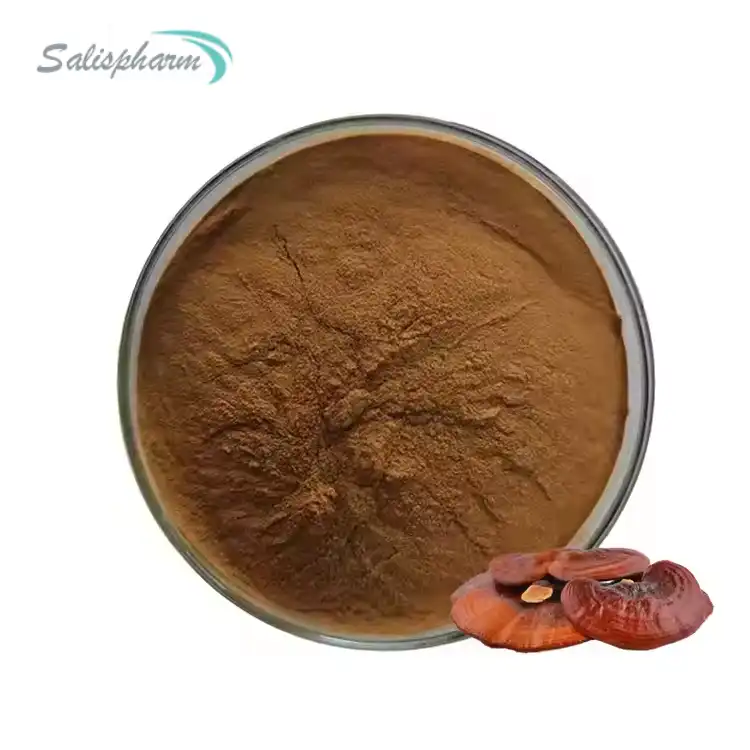Ganoderan 30% is a bioactive compound extracted from the medicinal mushroom Ganoderma lucidum, also known as Reishi or Lingzhi. This polysaccharide has gained significant attention in the scientific community due to its potential health benefits and therapeutic properties. Ganoderan is believed to possess immunomodulatory, anti-tumor, and antioxidant effects, making it a subject of interest in various fields of medical research.

What are the health benefits of Ganoderan?
Ganoderan 30%, derived from the Ganoderma lucidum mushroom, has been associated with numerous potential health benefits. Research suggests that this bioactive compound may offer a wide range of positive effects on human health:
- Immune system support: Ganoderan has been shown to enhance the activity of natural killer cells and other immune system components, potentially improving overall immune function.
- Anti-cancer properties: Studies have indicated that Ganoderan may possess anti-tumor effects, inhibiting the growth and spread of cancer cells in various types of cancer.
- Antioxidant activity: The compound demonstrates potent antioxidant properties, which may help protect cells from oxidative stress and reduce the risk of chronic diseases.
- Cardiovascular health: Some research suggests that Ganoderan may help lower blood pressure and cholesterol levels, potentially reducing the risk of heart disease.
- Anti-inflammatory effects: Ganoderan has been shown to possess anti-inflammatory properties, which may be beneficial in managing various inflammatory conditions.
- Liver protection: Studies have indicated that Ganoderan may help protect the liver from damage and support its function.
- Blood sugar regulation: Some research suggests that Ganoderan may help improve insulin sensitivity and glucose metabolism, potentially benefiting individuals with diabetes.
- Neuroprotective effects: Preliminary studies have shown that Ganoderan may have neuroprotective properties, potentially benefiting brain health and cognitive function.
It's important to note that while these potential benefits are promising, more research is needed to fully understand the extent of Ganoderan's effects on human health. As with any supplement or natural remedy, it's crucial to consult with a healthcare professional before incorporating Ganoderan into your health regimen.
How is Ganoderan extracted from Ganoderma lucidum?
The extraction of Ganoderan 30% from Ganoderma lucidum is a complex process that requires careful attention to detail and specialized techniques. The extraction method can significantly impact the quality and efficacy of the final product. Here's an overview of the typical extraction process:
- Harvesting and preparation: High-quality Ganoderma lucidum mushrooms are carefully harvested and cleaned to remove any impurities.
- Drying: The mushrooms are then dried using controlled temperature and humidity conditions to preserve their bioactive compounds.
- Grinding: The dried mushrooms are ground into a fine powder to increase the surface area for extraction.
- Hot water extraction: The powdered mushroom is subjected to hot water extraction, typically at temperatures between 80°C and 100°C, for several hours. This process helps to release the water-soluble polysaccharides, including Ganoderan.
- Alcohol extraction: Following hot water extraction, an alcohol extraction may be performed to isolate additional bioactive compounds.
- Filtration: The extracted liquid is filtered to remove any solid particles.
- Concentration: The filtered extract is then concentrated using various methods, such as vacuum evaporation or spray drying.
- Purification: Advanced purification techniques, such as column chromatography or membrane filtration, may be employed to isolate and purify Ganoderan from other compounds.
- Quality control: The final extract is subjected to rigorous quality control measures to ensure purity, potency, and safety.
It's worth noting that there are variations in extraction methods, and some manufacturers may use proprietary techniques to optimize the yield and quality of Ganoderan. The choice of extraction method can impact the composition and bioavailability of the final product, which is why it's essential to choose high-quality supplements from reputable sources.
Recent advancements in extraction technology have led to the development of more efficient and targeted methods for isolating Ganoderan. These include supercritical fluid extraction, enzyme-assisted extraction, and ultrasound-assisted extraction. These techniques aim to improve the yield and purity of Ganoderan while minimizing the use of harsh chemicals and preserving the integrity of the bioactive compounds.
Can Ganoderan be used as a natural alternative to traditional medicine?
The potential use of Ganoderan 30% as a natural alternative to traditional medicine has garnered significant interest in recent years. As more people seek holistic approaches to health and wellness, natural compounds like Ganoderan have come under the spotlight. However, it's important to approach this question with a balanced perspective, considering both the potential benefits and limitations of using Ganoderan as an alternative treatment.
Potential as a complementary therapy:
- Immune support: Ganoderan's immunomodulatory properties may make it a valuable complement to conventional treatments for immune-related disorders.
- Cancer adjuvant therapy: Some studies suggest that Ganoderan could potentially be used alongside conventional cancer treatments to enhance their efficacy and reduce side effects.
- Chronic disease management: The anti-inflammatory and antioxidant properties of Ganoderan may be beneficial in managing chronic conditions such as cardiovascular disease and diabetes.
- Stress and fatigue: Traditional use of Ganoderma lucidum suggests that Ganoderan may help in managing stress and fatigue, which could be valuable for overall well-being.
Considerations and limitations:
- Scientific evidence: While there is a growing body of research on Ganoderan, many studies are still in preclinical stages or have been conducted in vitro or on animal models. More robust clinical trials are needed to establish its efficacy in humans.
- Standardization: The concentration and composition of Ganoderan can vary depending on the source and extraction method, making it challenging to establish standardized dosages and treatment protocols.
- Regulatory status: In many countries, Ganoderan is classified as a dietary supplement rather than a medicine, which means it is not subject to the same rigorous testing and approval processes as pharmaceutical drugs.
- Interactions: As with any bioactive compound, there is a potential for interactions with other medications or supplements. It's crucial for individuals to consult with healthcare professionals before using Ganoderan, especially if they are taking other medications.
- Individual response: The effects of Ganoderan may vary from person to person, and what works for one individual may not be as effective for another.
While Ganoderan shows promise as a natural compound with potential health benefits, it should not be viewed as a direct replacement for traditional medicine. Instead, it may be more appropriate to consider it as a complementary therapy that can be used alongside conventional treatments under the guidance of healthcare professionals.
As research in this field continues to evolve, we may gain a better understanding of how Ganoderan 30% can be effectively integrated into holistic health approaches. For now, individuals interested in exploring the potential benefits of Ganoderan should do so with caution, seeking advice from qualified healthcare providers and choosing high-quality, well-researched products,lea_slsbio@163.com,WhatsApp+86 13193326505.
References
- Boh, B., Berovic, M., Zhang, J., & Zhi-Bin, L. (2007). Ganoderma lucidum and its pharmaceutically active compounds. Biotechnology Annual Review, 13, 265-301.
- Wachtel-Galor, S., Yuen, J., Buswell, J. A., & Benzie, I. F. F. (2011). Ganoderma lucidum (Lingzhi or Reishi): A Medicinal Mushroom. In Herbal Medicine: Biomolecular and Clinical Aspects (2nd ed.). CRC Press/Taylor & Francis.
- Xu, Z., Chen, X., Zhong, Z., Chen, L., & Wang, Y. (2011). Ganoderma lucidum polysaccharides: Immunomodulation and potential anti-tumor activities. The American Journal of Chinese Medicine, 39(01), 15-27.
- Jin, X., Ruiz Beguerie, J., Sze, D. M., & Chan, G. C. (2016). Ganoderma lucidum (Reishi mushroom) for cancer treatment. Cochrane Database of Systematic Reviews, (4).
- Sanodiya, B. S., Thakur, G. S., Baghel, R. K., Prasad, G. B., & Bisen, P. S. (2009). Ganoderma lucidum: a potent pharmacological macrofungus. Current Pharmaceutical Biotechnology, 10(8), 717-742.
- Gao, Y., Zhou, S., Huang, M., & Xu, A. (2003). Antibacterial and antiviral value of the genus Ganoderma P. Karst. species (Aphyllophoromycetideae): a review. International Journal of Medicinal Mushrooms, 5(3).
- Bishop, K. S., Kao, C. H., Xu, Y., Glucina, M. P., Paterson, R. R., & Ferguson, L. R. (2015). From 2000 years of Ganoderma lucidum to recent developments in nutraceuticals. Phytochemistry, 114, 56-65.
- Xiao, C., Wu, Q. P., Cai, W., Tan, J. B., Yang, X. B., & Zhang, J. M. (2012). Hypoglycemic effects of Ganoderma lucidum polysaccharides in type 2 diabetic mice. Archives of Pharmacal Research, 35(10), 1793-1801.
- Zhonghui, Z., Xiaowei, Z., & Fang, C. (2014). Ganoderma lucidum polysaccharides supplementation attenuates exercise-induced oxidative stress in skeletal muscle of mice. Saudi Journal of Biological Sciences, 21(2), 119-123.
- Zhao, H., Zhang, Q., Zhao, L., Huang, X., Wang, J., & Kang, X. (2012). Spore powder of Ganoderma lucidum improves cancer-related fatigue in breast cancer patients undergoing endocrine therapy: a pilot clinical trial. Evidence-Based Complementary and Alternative Medicine, 2012.

